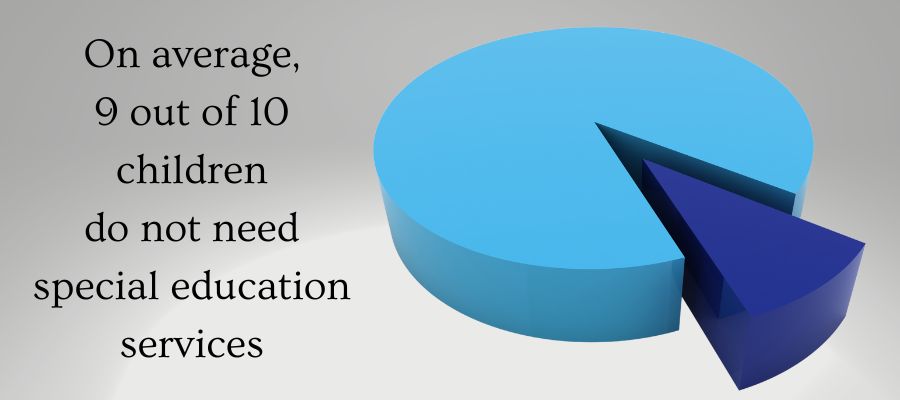I think that many speech language pathologists have had the experience where you are around your nieces and nephews or typically developing kids at a party, and are just blown away by how brilliant they are. Their language, their words, or how they navigate a social situation has you convinced that they are destined for a Gifted and Talented program. But then another child comes in who is equally smart, and then another… Spending most of our time around children with communication difficulties makes these “typical” children seem like communication geniuses. We have unwittingly become the victims of availability bias.
Availability bias is the result of making decisions based on exposure to specific experiences or on what is top-of-mind rather than using logic. Availability bias dictates that the easier it is to recall or imagine something, the more probable or consequential we perceive it to be.
Typically, availability bias is a really good thing because it is a mental shortcut that saves us loads of thinking time and relies on years of experience. But are there situations where it is not helpful or can cause us to make the wrong decision? You bet! Let’s look at some research and explore the way availability bias rears its head in our work as speech language pathologists.
Understanding Availability Bias: Insights from Research
Availability bias has been extensively studied in many industries because it leads to really costly mistakes.
Imagine two groups of individuals, each exposed to different narratives about investment properties. One group hears positive affirmations about property investments, while the other remains unaffected. When presented with a hypothetical investment scenario, those influenced by the positive narrative are more inclined to invest in property, showcasing the subtle yet potent influence of availability bias.
Which is more dangerous: police work or logging?
Similarly, consider the common misconception about the dangers of police work versus logging. Despite statistics showing logging to be more hazardous, availability bias leads most people to perceive policing as the riskier profession due to its frequent portrayal in the media.

Availability Bias in Speech Pathology: Navigating Referrals and Evaluations
In the realm of speech pathology, availability bias can profoundly impact decision-making processes, particularly when assessing new referrals or conducting evaluations.
Availability Bias in the Referral Process
The tendency to assume that every referral equates to a child qualifying for services stems from the prevalence of disabilities among the children we work with.
Yes, in theory, the referral process should be effective at removing children who wouldn’t qualify when we test them. But if it was working properly, we wouldn’t be experiencing the high rates of over-identification that is prevalent in many school districts. Secondly, caseloads would not be disproportionately skewed towards children from diverse backgrounds.
Availability Bias in the Evaluation Process
Availability bias can also influence both initial evaluations and re-evaluations. Tasked with determining whether a child has a disorder, it’s crucial to approach the evaluation with an assumption that the child will have typical results.
Why? Because approximately 9 out of 10 children have typical development. Typicality is the norm, just not what we see on a daily basis. As a simple example, let’s say I ask you to close your eyes and reach into a jar with 90 blue marbles and 10 green. I will give you $100 if you can guess which color you will pick.
The choice is obvious, right? Yet, when we do an evaluation and there is about a 90% chance that a child is typically developing, what frame of mind do we carry into the session? Statistics in all areas of special education reveal that the majority of children do not have disabilities (Edgar & Haden 1984), highlighting the importance of maintaining a balanced perspective. Adding to that, there are studies that show that children from diverse backgrounds have a much higher chance of being referred for evaluations because of cultural and linguistic mismatch between teachers and students (E. R. Williams, 2008), and that children who are referred for an evaluation have a greater than 50% chance of being diagnosed with a disability (Becker & Deris, 2019). Keeping those statistics in check as we head into each evaluation may help us avoid mis-diagnosis of children exhibiting cross-linguistic influence patterns.
How to Account for and Avoid Availability Bias
To mitigate the impact of availability bias, it’s essential to adopt a proactive approach grounded in critical thinking and evidence-based practices. Firstly, implementing robust referral processes that prioritize thorough assessments can help counteract the influence of availability bias, ensuring that only those in genuine need receive services. Alas, I don’t think that all of us are completely confident in the referral processes we have in the schools, or the opinions of doctors sending referrals to our clinics.
That means that we are the next line of defense. When conducting evaluations, it’s vital to approach each case with an open mind, free from preconceived notions or biases. When we are on the fence about qualifying a child, this is where we can bring our colleagues in to share our results and get a second opinion.
Bet on typicality – You may be surprised!
When evaluating or reevaluating a student, start from a place of typicality, not disorder.
- Especially if they have had services for a long time.
- Especially if they are older.
- Especially if their last evaluation was skipped.
- Especially if someone else did their last evaluation.
7 Types of Bias and How They Affect Speech Language Pathology
This is one of eight essays we wrote on bias, based on the work of Daniel Kahneman and the research we put together for the ASHA CEU course: How Ethics and Biases Shape Our Decisions: A Fun Look at Research on Heuristics. Start with the inspirational article on Daniel Kahneman and then work your way through seven ways our hidden biases can unknowingly influence our thinking.
- Navigating Fairness Bias in Our Role as SLPs
- Framing Effect: Shaping Perspectives with Words
- Understanding Availability Bias: Challenging Perceptions During Evaluations
- Deciphering the Conjunction Fallacy – Overlap or Isolation of Disorders?
- The Overconfidence Effect – Misperceptions About Amount of SLP Work and How Long it Takes
- Embracing Loss Aversion: Balancing Risk and Reward in Speech Pathology
- Freedom from the Anchoring Effect: When Numbers Work Against Us
How Ethics and Biases Shape Our Decisions: A Fun Look at Research on Heuristics
Edgar, E., & Hayden, A. H. (1984). Who Are the Children Special Education Should Serve and How Many Children Are There? The Journal of Special Education, 18(4), 523-539. https://doi.org/10.1177/002246698401800408




As a speech and language therapist, I have often felt the same bias at family parties, but this is, at least a positive one, where I can enjoy engaging with the children – and hopefully scoffing some cake at the same time! 🙂